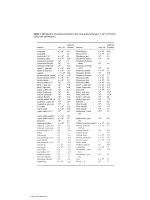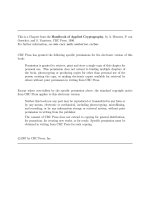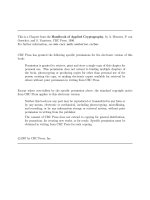handbook of brewing 2009 - eblinger
Bạn đang xem bản rút gọn của tài liệu. Xem và tải ngay bản đầy đủ của tài liệu tại đây (15.56 MB, 779 trang )
Handbook of Brewing
Edited by
Hans Michael Eßlinger
Further Reading
Ziegler, H. (Ed.)
Flavourings
Production, Composition, Applications, Regulations
Second, Completely Revised Edition
2007
ISBN: 978-3-527-31406-5
Surburg, H., Panten, J. (Eds.)
Common Fragrance and Flavor Materials
Preparation, Properties and Uses
Fifth, Completely Revised and Extended Edition
2006
ISBN: 978-3-527-31315-0
Brennan, J. G. (Ed.)
Food Processing Handbook
2006
ISBN: 978-3-527-30719-7
Handbook of Brewing
Processes, Technology, Markets
Edited by
Hans Michael Eßlinger
The Editor
Dr. Hans Michael Eßlinger
Freiberger Brauhaus AG
Am Fürstenwald
09599 Freiberg
Germany
All books published by Wiley-VCH are carefully
produced. Nevertheless, authors, editors, and
publisher do not warrant the information
contained in these books, including this book,
to be free of errors. Readers are advised to keep
in mind that statements, data, illustrations,
procedural details or other items may
inadvertently be inaccurate.
Library of Congress Card No.: applied for
British Library Cataloguing-in-Publication Data
A catalogue record for this book is available from
the British Library.
Bibliographic information published by the
Deutsche Nationalbibliothek
The Deutsche Nationalbibliothek lists this
publication in the Deutsche Nationalbibliografi e;
detailed bibliographic data are available on the
Internet at <>.
© 2009 WILEY-VCH Verlag GmbH & Co. KGaA,
Weinheim
All rights reserved (including those of translation
into other languages). No part of this book may
be reproduced in any form – by photoprinting,
microfi lm, or any other means – nor transmitted
or translated into a machine language without
written permission from the publishers.
Registered names, trademarks, etc. used in this
book, even when not specifi cally marked as such,
are not to be considered unprotected by law.
Composition SNP Best-set Typesetter Ltd.,
Hong Kong
Printing Betz-Druck GmbH, Darmstadt
Bookbinding Litges & Dopf GmbH,
Heppenheim
Printed in the Federal Republic of Germany
Printed on acid-free paper
ISBN: 978-3-527-31674-8
Contents
V
Handbook of Brewing: Processes, Technology, Markets. Edited by H. M. Eßlinger
Copyright © 2009 WILEY-VCH Verlag GmbH & Co. KGaA, Weinheim
ISBN: 978-3-527-31674-8
Preface XXVII
List of Contributors XXIX
1 A Comprehensive History of Beer Brewing 1
Franz G. Meussdoerffer
1.1 Introduction 1
1.2 ‘The Truly Happy Man Has His Mouth Full of Beer’: From Prehistory
to the End of the Roman Empire 2
1.2.1 Advent of Agrarian Societies 2
1.2.2 Mesopotamia and Egypt 5
1.2.3 Hellenistic Period: Greeks, Romans and Their Neighbors 7
1.2.4 Celts and the Germans 8
1.3 ‘I Would Like to Have a Great Lake of Beer for Christ the King’:
The Christian Middle Ages 9
1.3.1 Monasteries 9
1.3.2 Beginnings of Professionalism 12
1.4 ‘Woar Volk Is, Bint Klaantn’: Hopped Beer and the Seaports 16
1.4.1 Hanseatic League 16
1.4.2 Rise and Decline of the Cities in Central Europe 18
1.4.3 Rise of Dutch Brewing 20
1.5 ‘For a Quart of Ale is a Dish for a King’: John Bull and the
Industrialization of Brewing 21
1.6 ‘We Live in a Country Where Beer Constitutes Quasi the Fifth
Element’: Advent of Lager and the Internationalization of
Brewing 25
1.6.1 Bavaria and the Rise of Lager Beer 25
1.6.2 Spread of Lager Brewing 27
1.6.3 From Alchemy to Biochemistry: The Science of Brewing 30
1.6.4 Europe, the United States and the Internationalization of Beer
Brewing 33
References 37
VI Contents
2 Starchy Raw Materials 43
Franz Meussdoerffer and Martin Zarnkow
2.1 Introduction 43
2.2 Principles of Structure and Metabolism 44
2.2.1 Grain Structure 44
2.2.2 Basic Anabolic Processes 46
2.2.2.1 Starch Formation 47
2.2.2.2 Storage Proteins 50
2.2.2.3 Regulation of Grain Filling and Impact of Environmental
Factors 52
2.2.3 Catabolic Processes 53
2.3 Major Brewing Cereals 55
2.3.1 Introductory Remarks 55
2.3.2 Selected Cereals 59
2.3.2.1 Barley (H. vulgare L.) 59
2.3.2.2 Oats (Avena sativa L.) 60
2.3.2.3 Short-Grain Millet 61
2.3.2.4 Maize (Zea mays L.) 63
2.3.2.5 Rice (Oryza sativa L.) 64
2.3.2.6 Rye (Secale cereale L.) 65
2.3.2.7 Sorghum (Sorghum bicolor L.) 65
2.3.2.8 Wheat Group (Triticum L.) 66
2.3.3 Pseudocereals 69
2.3.3.1 Grain Amaranth (Main Sorts: Amaranthus cruenteus, Amaranthus
hypochondriacus and Amaranthus caudatus) 69
2.3.3.2 Buckwheat (Fagopyrum esculentum Moench) 70
2.3.3.3 Quinoa (Chenopodium quinoa Willd.) 70
2.4 Concluding Remarks 71
References 71
3 Hops 85
Martin Krottenthaler
3.1 Introduction 85
3.2 Cultivation of Hops 85
3.3 Components of Hops 87
3.3.1 Bitter Acids 87
3.3.2 Aroma Substances 88
3.3.3 Polyphenols 89
3.4 Hop Products 90
3.5 Analytics 91
3.6 Hopping Technology 91
3.6.1 General Aspects of Hop Addition 91
3.6.2 Beer with Hop Flavor 94
3.6.3 Beer with a Hop Flavor 95
3.6.4 Beer Enriched with Xanthohumol 97
Contents VII
3.6.5 Yield of Bitter Principles 97
3.6.6 Foam 98
3.6.7 Microbiology 99
3.6.8 Addition of ‘Downstream Products’ 99
3.7 Storage of Hops 100
References 101
4 Brew Water 105
Martin Krottenthaler and Karl Glas
4.1 General Requirements 105
4.2 Characteristics of Constituents Relevant for Brewing 105
4.3 Quality Criteria for Brew Water 108
4.4 Water Treatment 110
4.4.1 Removal of Problematic Inorganic Substances 110
4.4.1.1 Deferrization and Demanganization 110
4.4.1.2 Nitrate Reduction 111
4.4.2 Removal of Problematic Organic Substances 112
4.4.2.1 Aeration 112
4.4.2.2 Activated-Carbon Filtration 112
4.4.2.3 Combination Processes Using Oxidation/UV Irradiation 112
4.4.3 Common Processes for Brew Water Treatment 112
4.4.3.1 Lime Softening 112
4.4.3.2 Ion Exchange 113
4.4.3.3 Membrane Processes 115
References 117
5 Yeast 119
Christoph Tenge
5.1 Brewing Yeast 119
5.1.1 History of Yeast Research 119
5.1.2 Yeast for Brewing Applications 120
5.1.2.1 Flocculation 123
5.1.3 Yeast Morphology and Chemical Composition 124
5.1.3.1 Cell Wall 124
5.1.3.2 Periplasm 125
5.1.3.3 Cell Membrane 125
5.1.3.4 Cytoplasm 126
5.1.3.5 Mitochondria 126
5.2 Yeast Management 127
5.2.1 Nutrient Requirements and Intake 127
5.2.1.1 Carbohydrates and Fermentable Sugars 127
5.2.1.2 Nitrogen Sources 128
5.2.1.3 Oxygen 129
5.2.1.4 Minerals and Trace Elements 129
5.2.1.5 Vitamins and Other Growth Factors 130
VIII Contents
5.2.2 Metabolic Pathways during Propagation and Fermentation 131
5.2.2.1 Carbohydrate Metabolism for Cell Growth and Energy
Generation 131
5.2.2.2 Formation of Vicinal Diketones 132
5.2.2.3 Formation of Higher Alcohols 132
5.2.2.4 Formation of Esters 134
5.2.2.5 Phenolic Compounds 134
5.2.2.6 Formation of Sulfur Dioxide 135
5.2.3 Yeast Cultivation, Propagation and Post-Fermentation
Treatment 135
5.2.3.1 Yeast Cultivation in the Laboratory 136
5.2.3.2 Yeast Propagation in the Yeast Cellar 138
5.2.3.3 Post-Fermentation Treatment of Yeast 140
5.2.3.4 Yeast Crop 140
5.2.3.5 Yeast Treatment after Cropping and Yeast Storage 141
References 142
6 Malting 147
Stefan Kreisz
6.1 Brewing Barley 147
6.2 Barley Intake and Storage 149
6.2.1 Barley Cleaning 149
6.2.2 Steeping 150
6.2.3 Germination 152
6.2.4 Kilning 155
6.2.5 Cleaning, Storage and Polishing of the Malt 156
6.2.6 Malt Yield 157
6.2.7 Malt Quality 157
6.2.8 Quality Criteria of Barley Malt 158
6.2.8.1 Cytolysis 158
6.2.8.2 Proteolysis 160
6.2.8.3 Amylolysis 160
6.2.8.4 Enzymes 161
6.2.8.5 Further Malt Quality Criteria 161
6.3 Special Malts 163
6.3.1 Dark Malt (Munich Type) 163
6.3.2 Caramel (Crystal) Malt 163
6.3.3 Roasted Malt 164
6.3.4 Wheat Malt and Malt Made from Other Cereals 164
6.3.5 Other Special Malt 164
References 164
7 Wort Production 165
Martin Krottenthaler, Werner Back, and Martin Zarnkow
7.1 Introduction 165
7.2 Technology of Grinding 165
Contents IX
7.3 Mashing Technology 168
7.3.1 Mashing Parameters 169
7.3.2 Selected Mashing Processes 173
7.3.2.1 Step-Mashing Process 173
7.3.2.2 Maltase Process 174
7.3.2.3 Dark Beer Varieties 175
7.3.2.4 Adjunct Mashing 176
7.4 Technology of Lautering 181
7.4.1 Lauter Tun 182
7.4.2 Mash Filter 184
7.4.3 Strainmaster 186
7.5 Technological Basics of Wort Boiling 186
7.5.1 Hot Holding 186
7.5.2 Evaporation 187
7.5.3 Modern Boiling Systems 190
7.5.3.1 Internal Boilers 190
7.5.3.2 Optimized Internal Boiler ‘Stromboli’ 190
7.5.3.3 Optimized Internal Boiler Subjet 191
7.5.3.4 External Boiler 192
7.5.3.5 High-Temperature Wort Boiling 194
7.5.3.6 Dynamic Low-Pressure Boiling 194
7.5.3.7 Soft Boiling Method ‘SchoKo’ 194
7.5.3.8 Wort Stripping 196
7.5.3.9 Vacuum Evaporation 197
7.5.3.10 Flash Evaporation ‘Varioboil’ 197
7.5.3.11 Thin Film Evaporator ‘Merlin’ 199
7.5.4 Vapor Condensate 201
7.5.5 Cold Trub 202
References 202
8 Fermentation, Maturation and Storage 207
Hans Michael Eßlinger
8.1 Pitching 207
8.2 Aeration 209
8.3 Topping-up 209
8.4 Changes during Fermentation 209
8.4.1 Changes in the Composition of Nitrogen Compounds 211
8.4.2 pH Drop 211
8.4.3 Changes in the Redox Properties of Beer 212
8.4.4 Beer Color 212
8.4.5 Precipitation of Bitter Substances and Polyphenols 212
8.4.6 CO
2
Content 212
8.4.7 Clarifi cation and Colloidal Stabilization 213
8.5 Appearance during Fermentation 213
8.6 Fermentation Parameters 213
8.7 Control of Fermentation 214
X Contents
8.8 Fermenters 214
8.9 Maturation 215
8.10 Storage 215
8.11 Bottom Fermentation in Practice 216
8.11.1 Cold Fermentation with Conventional Storage 216
8.11.2 Cold Fermentation with Well-Directed Maturation in a Cylindroconical
Vessel (CCV) 217
8.11.3 Pressureless Warm Fermentation 217
8.11.4 Accelerated Fermentation under CO
2
Pressure 217
8.11.5 Cold Fermentation with Integrated Maturation at 12 °C 218
8.11.6 Cold Fermentation with Programmed Maturation at 20 °C 219
8.11.7 Accelerated Fermentation and/or Maturation 219
8.12 Yeast Crop and Yeast Storage 220
8.13 Beer Recovery from Yeast 221
8.14 CO
2
Recovery 221
8.15 Types of Bottom-Fermented Beers 222
8.16 Top Fermentation 222
8.17 Types and Production of Top-Fermented Beers 223
8.17.1 Wheat Beer 223
8.17.2 Alt Beer 223
8.17.3 Kölsch Beer 224
References 224
9 Filtration and Stabilization 225
Bernd Lindemann
9.1 Introduction 225
9.2 Purpose of Filtration 225
9.3 Theoretical Considerations of Cake Filtration 225
9.4 Filtration Techniques 226
9.4.1 Kieselguhr Filtration 226
9.4.1.1 Plate and Frame Filter 227
9.4.1.2 Horizontal Leaf Filter 227
9.4.1.3 Metal Candle Leaf Filter 229
9.4.2 Filter Aids for Pre-coating 230
9.4.3 Methods in Kieselguhr Pre-coating Filtration 230
9.4.4 Membrane Filtration 230
9.5 Variables Infl uencing Beer Filtration 231
9.6 Beer Stabilization 231
9.7 Technical Design of a Filtration and Stabilization Plant 232
References 234
10 Special Production Methods 235
Felix Burberg and Martin Zarnkow
10.1 Alcohol-Free Beers 235
10.1.1 Introduction 235
Contents XI
10.1.2 Techniques for the Production of Alcohol-Free Beers 236
10.1.2.1 Physical Techniques 236
10.1.2.2 Biological Methods 238
10.1.2.3 Combination Physical-Biological Processes 240
10.2 Dietetic Beer 240
10.2.1 Introduction 240
10.2.2 Methods for the Production of Dietetic Beers 241
10.3 ‘Nährbier’ and ‘Malzbier’ (‘Malztrunk’) 242
10.3.1 Introduction 242
10.3.2 Methods for the Production of ‘Nährbier’ and ‘Malzbier’
(‘Malztrunk’) 242
10.4 XAN™ Wheat Beer 243
10.4.1 Introduction 243
10.4.2 Methods of Production of XAN™ Wheat Beer 243
10.5 Gluten-Free Beer 244
10.5.1 Introduction 244
10.5.2 Production Methods for Gluten-Free Beer 244
10.5.2.1 Conventional ‘Gluten-Containing’ Raw Material 245
10.5.2.2 Sources of Gluten-Free Sugars and Starch 245
10.6 Brewing with High Original Wort 246
10.6.1 Introduction 246
10.6.2 Methods for Beer Production with High Original Wort 247
10.7 Ale and Cask-Conditioned Ale 248
10.7.1 Introduction 248
10.7.2 Methods for the Production of Cask-Conditioned Ale 249
10.8 Lambic, Gueuze and Fruit Lambic 250
10.8.1 Introduction 250
10.8.2 Method for the Production of Lambic and Gueuze 251
10.8.2.1 Wort Production 251
10.8.2.2 Beer Production 251
10.8.3 Method for the Production of Fruit Lambic 252
10.9 Berliner Weisse 253
10.9.1 Introduction 253
10.9.2 Method for the Production of Berliner Weisse 254
10.10 Porter 254
10.10.1 Introduction 254
10.10.2 Method for the Production of Porter Bier 255
10.11 Summary 255
References 255
11 Beer-Based Mixed Drinks 257
Oliver Franz, Martina Gastl, and Werner Back
11.1 Development of Beer-Based Mixed Drinks 258
11.2 Ingredients and Mixing Formulations 260
11.2.1 Constituent Beer 260
XII Contents
11.2.2 Water Quality 261
11.2.3 Sweetening 261
11.2.3.1 Sweetening Agents 261
11.2.4 Food Acids 262
11.2.5 Flavor and Juices 263
11.3 Quality Control of Beer-Based Mixed Drinks 263
11.3.1 Wet Chemical Analysis 263
11.3.2 Sensory Assessment of Beer-Based Mixed Drinks 264
11.3.3 Assessment by the Deutsche Landwirtschafts-Gesellschaft (DLG)
(German Agricultural Society) 264
11.3.4 Off-fl avors 266
11.4 Microbiology of Beer-Based Mixed Drinks 268
11.5 Preservation of the Final Beverage 269
11.5.1 Use of Antioxidants 269
11.5.2 Use of Preserving Agents 269
11.5.3 Thermal Processes – Pasteurization 269
11.6 Technological Aspects for the Production of Beer-Based Mixed
Drinks 270
11.6.1 Mixing 270
11.6.2 Filtration 271
11.6.3 Filling 272
11.6.4 Infl uence of the Packaging 272
11.7 Technical Equipment for the Production of Beer-Based Mixed
Drinks 273
References 273
12 Filling 275
Susanne Blüml
12.1 Choice of Packaging 275
12.1.1 Glass Bottles 275
12.1.2 Cans 277
12.1.3 Plastic Bottles 278
12.1.4 Kegs 280
12.2 Framework Conditions for Filling Beer 281
12.2.1 Signifi cance of the Gases 282
12.2.1.1 Oxygen Content 282
12.2.1.2 CO
2
Content 283
12.2.2 Filling Pressure 284
12.2.3 Temperature 285
12.3 Process Steps When Filling Beer 285
12.3.1 Evacuation 285
12.3.2 Flushing with Ring-Bowl or Pure Gas 287
12.3.2.1 Flushing with Ring-Bowl Gas 288
12.3.2.2 Flushing with Pure Gas 288
12.3.3 Pressurization 288
Contents XIII
12.3.4 Filling 288
12.3.5 Settling and Snifting 290
12.4 Filling Systems for Beer 290
12.4.1 Mechanical Level-Controlled Filling Systems 290
12.4.1.1 Mecafi ll VKPV – The Mechanical System for Bottling
Beer 292
12.4.2 Electronic Level-Controlled Filling Systems 292
12.4.2.1 Sensometic VPVI – Filling With an Electronic Probe 294
12.4.2.2 Sensometic VPL-PET – Probe-Controlled Long-Tube Filler for
Single-Chamber and Multi-Chamber Operation 295
12.4.3 Electronic Volumetric Filling Systems 296
12.4.3.1 Volumetic VOC – The Can Filler 297
12.4.3.2 Volumetic VODM-PET – Filling With Flow-Metered Quantitative
Measurement 300
12.4.4 Associated System Modules 301
12.4.4.1 Fobbing 301
12.4.4.2 Crowners 303
12.4.4.3 Screw-Cappers for Plastic Screw Caps 304
12.5 Constituent Parts of a Bottling Line 305
12.5.1 Bottle Washer 305
12.5.1.1 Treatment zones 306
12.5.1.2 Components of a Bottle Washer 307
12.5.1.3 Typical Bottle Treatment Sequence 311
12.5.2 Inspection and Monitoring Units 313
12.5.2.1 Machine Types 313
12.5.2.2 Inspection Tasks 316
12.5.2.3 Inspection Technology 318
12.5.2.4 Reliability of the Inspectors 319
References 320
13 Labeling 321
Jörg Bückle
13.1 Some Basic Remarks on Machine Construction 321
13.2 Wet-Glue Labeling 324
13.2.1 Foiling 326
13.3 Hotmelt Labeling 327
13.3.1 Hotmelt Labeling with Pre-cut Labels 328
13.3.2 Reel-Fed Hotmelt Labeling 330
13.3.3 Roll on/Shrink on 331
13.3.4 Tamper-Evident Seals 332
13.4 Pressure-Sensitive Labeling 332
13.5 Sleeving 334
13.5.1 Stretch-Sleeve Process 335
13.5.2 Shrink-Sleeve Process 336
13.6 Date Coding and Identifi cation 337
XIV Contents
14 Beer Dispensing 339
Reinhold Mertens
14.1 Beer Quality in the Draft Beer System 339
14.1.1 Temperature 339
14.1.2 Time on Tap 339
14.1.3 CO
2
Content 339
14.1.4 Foamhead 341
14.1.5 Pouring the Beer 341
14.2 Design of Draft Beer Systems 341
14.2.1 Requirements for Rooms 341
14.2.2 Requirements for Refrigeration 342
14.2.2.1 Storage/Cabinet Cooling 342
14.2.2.2 Ancillary Cooling 342
14.2.2.3 Bar Cooling 342
14.2.3 Requirements for Beer Lines 342
14.2.4 Requirements for CO
2
Lines 343
14.2.5 Requirements for Beer Bars/Bar Counter 343
14.2.6 Requirements for Glass-Washing Equipment 343
14.2.6.1 Two-Sink Installation 343
14.2.6.2 Glass Cleaning System 343
14.2.6.3 Glass Washing Machines 344
14.2.7 Calculation of Applied Gauge Pressure 344
14.3 Dispensing 346
14.3.1 Types of Dispensing 346
14.3.1.1 Dispensing from Underneath the Beer Bar 346
14.3.1.2 Dispensing from above the Beer Bar 346
14.3.1.3 Dispensing Direct from the Beer Bar 346
14.3.2 Dispensing with Beer Pumps 346
14.3.3 Dispensing Beer with Pre-mixed Gas (CO
2
/N
2
) 348
14.3.4 Use of Gas Blenders 349
14.3.5 Computerized Beer Dispensing 349
14.3.6 Beer-Dispensing Tanks 350
14.4 Parts of Draft Beer Systems 350
14.4.1 Requirements for Gas-Pressurized Parts 350
14.4.2 Requirements for Beverage Parts 351
14.4.3 Keg-Tapping Equipment 351
14.5 Hygiene Requirements in Draft Beer Systems 352
14.5.1 Hygiene Target 352
14.5.2 Cleaning and Disinfecting Procedures 353
14.5.3 Hygiene Problem Areas 354
14.6 Testing 355
14.6.1 Hygiene Testing 355
14.6.2 Leak Tests 355
14.6.3 Temperature Tests 355
14.7 Safety Precautions 356
Contents XV
14.7.1 CO
2
Gas Alert Units 356
14.8 Final Remarks 356
Reference 357
15 Properties and Quality 359
August Gresser
15.1 Composition of Finished, Bottom-Fermented Beer 359
15.2 Overall Qualities of Bottom-Fermented Beer 360
15.3 Redox Potential 360
15.4 Beer Color 360
15.5 Taste of Beer 361
15.6 Beer Foam 361
15.6.1 Basis of Beer Foam 362
15.6.2 Infl uence of Gas 362
15.6.3 Infl uence of Foam Stability 362
15.6.4 Infl uence of Brewing Liquor 362
15.6.5 Infl uence of Hop Products 363
15.6.6 Infl uence of Malt 363
15.6.7 Infl uence of Mash Filtration 363
15.6.8 Wort Boiling 363
15.6.9 Cold Break Removal 364
15.6.10 Main Fermentation 364
15.6.11 Storage Conditions 364
15.6.12 Beer Filtration 365
15.6.13 Precocious Indicators for the Foam Appearance 365
15.6.14 Conclusion 365
15.7 Bitter Substances in Hops 366
15.7.1 Infl uence of Cohumulone on the Bittering Quality 368
15.7.2 Infl uence of Cohumulone on Foam Stability 369
15.7.3 The Infl uence of Cohumulones on Beer Aging 369
15.8 Aroma Substances in Hops 371
15.9 Polyphenols in Beer Production 371
15.9.1 Defi nition of Polyphenols 373
15.9.2 Origin of Polyphenols 373
15.9.2.1 Malt Polyphenols 373
15.9.2.2 Hop Polyphenols 374
15.9.4 Polphenolic-Related Reactions during Brewing 379
15.9.4.1 Reaction with Proteins 379
15.9.4.2 Infl uence of Hops 379
15.9.4.3 Advantages and Disadvantages 379
15.9.5 Value of Anthocyanogens and Other Beer Characteristics 380
15.9.6 Reaction Path of Polyphenolic Components during the Brewing
Process 380
15.9.7 Conclusions 381
15.10 N-Heterocycles 381
XVI Contents
15.10.1 Presence of Heterocycles 381
15.10.2 N-Heterocycles in the Malting Process 383
15.10.3 Mashing Conditions 383
15.10.4 Wort Boiling 386
15.11 DMS 386
15.11.1 Formation of DMS 386
15.11.2 Barley and Malt 387
15.11.3 Temperature 387
15.11.4 Withering and Kilning 387
15.11.5 Malt Cleaner 388
15.11.6 Brewhouse 388
15.12 Gushing (Uncontrolled Overfl ow or Overfoaming of Beer) 389
15.12.1 General 389
15.12.2 Determination of the Gushing Behavior of Beer Induced by Raw
Materials 389
15.12.3 Metal Ions in Bottled Beer 389
15.12.4 Precipitation of Calcium Oxalate Crystals 390
15.12.5 Filter Media 392
15.12.6 Malt-Induced Gushing 392
15.12.7 Chemical Components Causing Gushing 394
References 395
16 Stability of Beer 399
August Gresser
16.1 Flavor Stability 399
16.1.1 Introduction 399
16.1.2 Reasons for Beer Aging 401
16.1.3 Changes of Aromatic Compounds 402
16.1.4 Defi nition of Indicator Substances 403
16.1.5 Technological Measurements to Preserve Organoleptic Stability 404
16.1.5.1 Barley Variety 404
16.1.5.2 Germination 405
16.1.5.3 Wort Preparation 409
16.1.5.4 Mash Filtration 413
16.1.5.5 Wort Boiling 413
16.1.5.6 Hot Break Removal 414
16.1.5.7 Flotation (Removal of Cold Break) 414
16.1.5.8 Yeast Handling 414
16.1.5.9 Fermentation and Maturation 417
16.1.5.10 Filtration 418
16.1.5.11 Filling 420
16.1.5.12 Analytical Control of Flavor Stability and Stale Flavor
Compounds 422
16.2 Lightstruck Flavor 423
16.3 Colloidal Stability of Beer 428
Contents XVII
16.3.1 Introduction 428
16.3.1.1 Composition of Turbidity in Beer 430
16.3.2 Mechanism of Turbidity Formation 430
16.3.3 Infl uence of Raw Materials and Auxiliary Materials 431
16.3.4 Brewhouse 431
16.3.4.1 Malt Milling 431
16.3.4.2 Mashing Procedure 431
16.3.4.3 Mash Filtration 431
16.3.4.4 Wort Boiling 431
16.3.4.5 Hot Break 431
16.3.5 Fermentation and Storage 432
16.3.6 Filtration 432
16.4 Stabilization Systems 432
References 434
17 Analysis and Quality Control 437
Heinz-Michael Anger, Stefan Schildbach, Diedrich Harms, and Katrin Pankoke
17.1 Introduction 437
17.2 Analyses 439
17.2.1 Density, Extract, Alcohol Content, Original Gravity and Degree of
Fermentation 440
17.2.2 Photometric Measurements 444
17.2.2.1 Color 445
17.2.2.2 Free Amino Nitrogen (FAN) 446
17.2.2.3 Bitter Units 446
17.2.2.4 Photometric Iodine Reaction 446
17.2.2.5 Thiobarbituric Acid Index (TBI) 446
17.2.2.6 Total Polyphenols and Anthocyanogens 447
17.2.2.7 Ions 447
17.2.2.8 α-Amylases According to EBC/ASBC: Dextrinizing Units 447
17.2.2.9 Other Photometric Measurements 447
17.2.3 pH Measurement 448
17.2.4 Conductivity 449
17.2.5 Titration Methods 449
17.2.5.1 Acid–Base Titration 449
17.2.5.2 Complexometric Titration 450
17.2.5.3 Manganometric Titration 450
17.2.5.4 Diastatic Power: Iodometric Titration 450
17.2.6 Determination of Nitrogenous Compounds 451
17.2.6.1 Determination According to Kjeldahl 451
17.2.6.2 Determination According to Dumas (Combustion
Method) 451
17.2.6.3 Near-IR Transmission Spectroscopy 451
17.2.6.4 Fractions of Nitrogenous Compounds 452
17.2.7 Carbon Dioxide 453
XVIII Contents
17.2.8 Measurement of Oxygen 454
17.2.9 Measurement of Chlorine Dioxide by a Sensor 455
17.2.10 Head Retention (Foam) 455
17.2.11 Turbidity and Non-Biological Stability 456
17.2.12 Viscosity 457
17.2.13 Congress Mash 458
17.2.14 Spent Grain Analysis 459
17.2.15 Friabilimeter 459
17.2.16 Grading 460
17.2.17 Hand Assessment 460
17.2.18 Homogeneity and Modifi cation 460
17.2.19 Protein Electrophoreses 460
17.2.20 Gushing 461
17.2.21 Hop Bitter Substances 461
17.2.22 Continuous Flow Analysis (CFA) 461
17.2.23 Chromatographic Analyses 461
17.2.23.1 High Performance Liquid Chromatography (HPLC) 462
17.2.23.2 Gas Chromatography (GC) 463
17.2.24 Enzymatic Analyses 464
17.2.25 Determination of the Calorifi c Value of Beer 466
17.2.26 Atomic Absorption Spectroscopy (AAS) and Inductively Coupled
Plasma Optical Emission Spectrometry (ICP-OES) 466
17.2.27 Sulfur Dioxide: Distillation Method 467
17.2.28 Emzyme Linked Immuno Sorbent Assay (ELISA) 468
17.2.29 Electron Spin Resonance Spectroscopy (ESR) 469
17.3 Analyses in Daily Quality Control 469
References 473
18 Microbiology 477
Werner Back
18.1 Microfl ora in the Brewery 477
18.2 Manufacturing Cultures 479
18.3 Foreign Yeasts 480
18.4 Beer-Spoilage Bacteria 481
18.5 Detection of Beer Pests 484
References 490
19 Certifi cation 491
Bernd Lindemann
19.1 Management Systems and Business Management 491
19.2 Management Systems Standards 491
19.2.1 DIN EN ISO 9000, 9001 and 9004 492
19.2.2 DIN EN ISO 14001 492
19.2.3 DIN EN ISO 22000 492
19.2.4 Global Food Safety Initiative 493
Contents XIX
19.2.5 IFS 493
19.2.6 BRC 494
19.2.7 DIN EN ISO 17025 494
19.3 Principles and Similarities 494
19.4 Legal Requirements 495
19.4.1 Regulation (EU) 178 495
19.4.2 Regulation (EU) 852 495
19.5 Certifi cation According to ISO Standards 495
19.6 Certifi cation through IFS and BRC 496
19.7 Certifi cation through HACCP 496
20 World Beer Market 497
Jens Christoph Riese and Hans Michael Eßlinger
20.1 Introduction 497
20.2 Statistics 498
20.2.1 Raw Materials for Brewing 498
20.2.1.1 Barley and Malt Market 498
20.2.1.2 Global Malt Production 501
20.2.2 Beer Consumption 503
20.2.3 Beer Styles 503
20.2.4 Packaging 505
20.3 Beer Markets and Their Key Players in 2004 505
20.3.1 Beer Markets 507
20.3.1.1 Europe 507
20.3.1.2 America 508
20.3.1.3 Asia 509
20.3.1.4 Africa 509
20.3.1.5 Australia and Pacifi c Beer Markets 509
20.3.1.6 Profi tability 510
20.3.2 World’s Top Brewers 510
20.3.3 Branding in the Global Brewing Industry 511
References 513
21 Physiology and Toxicology 515
Manfred Walzl
21.1 Astounding Health Benefi ts of Beer 515
21.2 Beer and Alcohol 521
21.3 Beer and Cancer 521
21.4 Beer Helps to Protect the Stomach and the Arteries 522
21.5 Lower Risk of Developing Kidney Stones 522
21.6 Ideal Sports Drink 523
21.7 Improved Concentration, Better Performance and Quicker
Reactions 523
21.8 Against Bacteria 524
21.9 Beer Removes Metals from the Organism 524
XX Contents
21.10 Beer is ‘Clean’ 525
21.11 Beer Makes Beautiful 525
21.12 Benefi cial Minerals 526
21.13 Legend of the Beer Belly 527
21.14 ‘Beer Prescription’ 527
References 528
22 Automation 531
Georg Bretthauer, Jens Uwe Müller, and Markus Ruchter
22.1 Introduction 531
22.2 Measurement Technology 533
22.2.1 Level 534
22.2.2 Temperature 534
22.2.3 pH Value 536
22.2.4 Pressure 536
22.2.5 Flow 536
22.2.6 Conductivity 537
22.2.7 Oxygen 538
22.2.8 Turbidity 539
22.2.9 Dosing 541
22.2.10 Limit Monitors 541
22.2.11 ‘In-Line’ Measurement 541
22.3 Control Strategies 542
22.3.1 Classic Algorithms 542
22.3.2 Advanced Algorithms 543
22.3.3 Advanced Control of the Lauter Tun 545
22.3.3.1 Description of the Lauter Tun 545
22.3.3.2 Process Characteristics 547
22.3.3.3 Structure of the Controller 548
22.3.3.4 Results 548
22.4 Process Control System (PCS) 550
22.5 Information Technologies 551
22.6 Conclusions 552
References 554
23 Malthouse and Brewery Planning 555
Walter Flad
23.1 Malthouse Planning 555
23.1.1 Introduction 555
23.1.2 Storage of Barley and Malt 555
23.1.3 Steeping 556
23.1.4 Germination 556
23.1.5 Kilning 557
23.1.6 Show Case Malting Plant 557
23.1.6.1
Design of the Steeping, Germination and Kilning Tower 557
Contents XXI
23.1.6.2 Calculations 560
23.1.7 Consumption Data 561
23.2 Brewery Planning 562
23.2.1 Brewhouse 563
23.2.2 Wort Cooling 564
23.2.3 Malt Silos and Malt Treatment 564
23.2.4 Fermenting, Maturation and Storage Tanks 565
23.2.5 Yeast Management 566
23.2.6 Filtration 566
23.2.7 Bright Beer Tanks 566
23.2.8 Bottling Plant 567
23.2.9 Kegging Plant 567
23.2.10 Space Requirement of Full Packs and Returned Empties 567
23.2.11 Utilities and Power Supply 568
23.2.11.1 Supply with Heat 568
23.2.11.2 Supply with Coldness 568
23.2.11.3 CO
2
Recovery 569
23.2.11.4 Supply with Compressed Air 569
23.2.11.5 Supply with Electrical Power 569
23.2.11.6 Supply with Fresh Water 569
23.2.12 Key Figures for New Breweries 569
23.2.12.1 Required Land Area 569
23.2.12.2 Required Investment Costs 573
23.2.13 Documentation and Specifi cations 575
References 576
24 Packaging 577
Jörg Bückle
24.1 Selecting the Suitable Machine Confi guration 577
24.2 Packing into Packs Open at the Top 578
24.2.1 Classical Machine Design 578
24.2.2 Robot Technology 582
24.3 Wrap-around Packaging 584
24.4 Shrink-Wrap Packaging 587
24.5 Multipacks Made of Paperboard 592
24.6 Multipacks with a Plastic Carrier 593
25 Cleaning and Disinfecting 595
Udo Praeckel
25.1 Cleaning 596
25.1.1 Cleaning Agents 597
25.1.1.1 Alkaline Cleaning Agents 597
25.1.1.2 Acidic Cleaning Agents 599
25.2 Disinfecting 600
25.3 Cleaning Methods 603
XXII Contents
25.3.1 Non-Recovery CIP Cleaning Method 603
25.3.2 Recovery Tank CIP Cleaning Method 604
25.3.3 Combined CIP Cleaning Method 605
25.4 Material Compatibility 611
25.5 Cleaning Glass Bottles 613
25.5.1 Bottle-Cleaning Machine 614
25.5.1.1 Residual Draining 614
25.5.1.2 Pre-soak with Pre-spray 615
25.5.1.3 Main Caustic Soaker Bath and Caustic Spray 615
25.5.1.4 Intermediate Spray, Hot- and Cold-Water Zones 615
25.5.2 Use of Chemicals in the Bottle-Washing Machine 616
25.6 Cleaning PET Bottles 617
25.7 Cleaning Barrels 617
25.8 Foam Cleaning 619
25.9 Work Safety and Environmental Protection 620
26 Waste Water 621
Karl Glas
26.1 Introduction 621
26.2 Characterization of Brewery Waste Water 621
26.2.1 Types of Waste Water 621
26.2.2 Waste water Constituents 622
26.2.3 Analysis of Waste Water 623
26.3 Preliminary Investigations to Determine Waste Water Pollutant Load
and to Plan Waste Water Plants 625
26.4 Practical Example of a Waste Water Measurement 626
26.4.1 Determination of Concentration and Volume 626
26.4.2 Load Values 626
26.5 Specifi c Characteristic Parameters of Waste Water 627
26.5.1 Total Waste Water 627
26.5.2 Split Streams 629
26.6 In-house Measures 631
26.6.1 Classifi cation of In-house Measures 631
26.6.2 Goal of In-house Measures 632
26.6.3 Practical Check-List of In-house Measures for the Production
Steps 632
26.7 Waste Water Treatment 632
26.7.1 Neutralization 632
26.7.1.1 Neutralization of Carbonic Acid (CO
2
) 632
26.7.1.2 Neutralization with Flue Gas 634
26.7.2 Mixing and Equalizing Tanks 634
26.7.3 Aerobic Waste Water Treatment 635
26.7.3.1 Activated-Sludge Plant 635
26.7.3.2 High-Performance Reactors 636
26.7.3.3 SBR 636
Contents XXIII
26.7.3.4 Aerated Waste Water Ponds 637
26.7.4 Anaerobic Waste Water Treatment 637
26.7.4.1 Biochemical Basics 637
26.7.5 Combination of Aerobic–Anaerobic Techniques 640
26.7.6 Comparison of Anaerobic and Aerobic Techniques 640
References 641
27 Energy 643
Georg Schu
27.1 Introduction 643
27.2 Heat Requirements of the Brewery 643
27.2.1 Heat Consumption in the Brewery 644
27.2.1.1 Brewhouse 644
27.2.1.2 Service Warm Water 645
27.2.1.3 Keg Cleaning 646
27.2.1.4 Bottle-Rinsing Machinery 646
27.2.1.5 Others (Pasteurization, Flash Pasteurization, CIP) 646
27.2.1.6 Room Heating and System Losses 647
27.2.2 Boiler House 647
27.2.2.1 Boiler Plant and Combustion 647
27.2.2.2 Heat Carrier Systems 647
27.2.2.3 Fuels 648
27.2.3 Optimization Possibilities: Exhaust Emission Heat Exchanger,
Degassing, Oxygen Regulation, Water Treatment and
Blow-Off 648
27.2.4 Possibilities for Heat Recovery 648
27.2.4.1 Wort Cooling 648
27.2.4.2 Vapor Condenser 650
27.2.4.3 Waste Heat from Vapor Condensate 650
27.2.4.4 Waste Heat from Compressed Air 650
27.2.4.5 Waste Heat from the Refrigeration System 651
27.3 Power Supply 652
27.3.1 Requirement Figures 652
27.3.2 External Power Supply 652
27.3.2.1 Supply and Measurement at the Release Point 652
27.3.2.2 Power Factor Correction 653
27.3.2.3 Supply Contracts 653
27.3.3 Electric Power Consumption of the Brewery 653
27.3.3.1 The Brewhouse 653
27.3.3.2 The Filling Area 654
27.3.3.3 Drive System and Components 655
27.3.3.4 Lighting 655
27.3.3.5 Heat Supply 656
27.3.4 Optimization of the Electrical Power Supply: Load Management 656
27.3.5 Combined Heat and Power (CHP) 657
XXIV Contents
27.4 Cold Supply 657
27.4.1 Cooling Requirements 658
27.4.1.1 Design of Fermentation and Storage Cellar 658
27.4.1.2 Location/Climatic Zone 658
27.4.2 Cold Production 658
27.4.3 Goals for an Optimal Cold Supply 661
27.5 Compressed Air Supply 662
References 663
28 Environmental Protection 665
Jochen Keilbach
28.1 Introduction 665
28.2 Environmentally Relevant Subjects in Relation to
Brewing 665
28.2.1 Waste Water 665
28.2.1.1 Avoidance of Waste Water by Reduction of Water Usage 665
28.2.1.2 Composition of Brewery Waste Water 666
28.2.1.3 Waste Water Disposal 667
28.2.2 Energy 668
28.2.2.1 Renewable Energy 669
28.2.3 Brewery Emissions 670
28.2.3.1 Gaseous Emissions 670
28.2.3.2
Dust Emissions 672
28.2.3.3
Noise Emission 672
28.2.4 Waste 673
28.2.4.1
Special Brewery-Specifi c Production Waste 673
References 674
29 Sensory Evaluation 675
Bill Taylor and Gregory Organ
29.1 Introduction to the Five Senses 675
29.2 How to Assess the Flavor of Beer 676
29.2.1 Technique for Flavor Assessment 677
29.2.2 Additional Points 677
29.2.3 Requirements for Attendance 678
29.2.4 Overall Assessment 678
29.3 Description of the Main Flavor Attributes 679
29.3.1 Sulfur Dioxide 679
29.3.2 Hydrogen Sulfi de/Mercaptan 680
29.3.3 Dimethylsulfi de/Cooked Vegetable 681
29.3.4 Solvent 682
29.3.5 Acetaldehyde 682
29.3.6 Estery/Fruity 682
29.3.7 Hoppy 683









